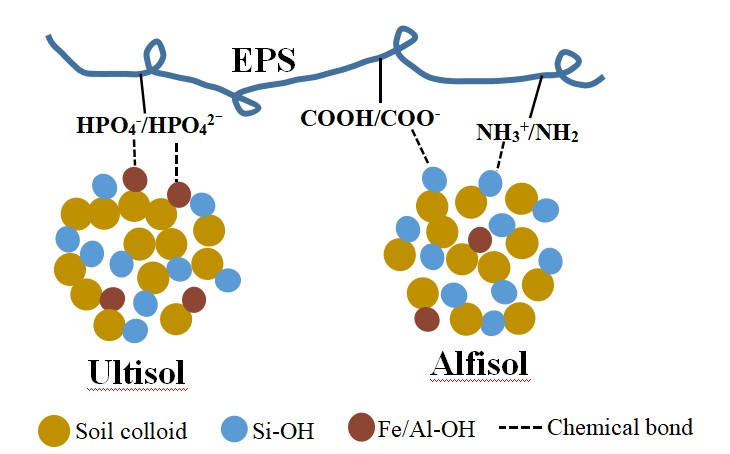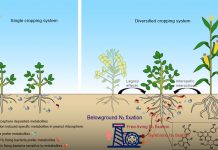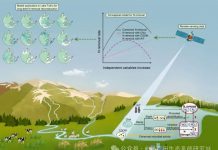土壤中细菌的生长与代谢过程伴随着胞外聚合物的产生,胞外聚合物含丰富的羧基、羟基、磷酸根等官能团,可在土壤表面发生吸附并影响土壤的电化学性质及土壤对养分的保持能力。但胞外聚合物在土壤表面的吸附能力受pH、离子强度等溶液条件的影响,已有研究大多采用纯矿物或合成的铁铝氧化物,对细菌保温聚合物在实际土壤中的吸附行为知之甚少。
徐仁扣课题组借助原位红外光谱技术(ATR-FTIR)结合电化学分析方法,研究了两种细菌胞外聚合物(EPS)在红壤和黄棕壤胶体表面的吸附容量及其结合机制。研究发现黄棕壤吸附较多的EPS-C和EPS-N,而红壤对EPS-P具有更高的吸附容量。EPS-C、EPS-N和 EPS-P 在红壤和黄棕壤表面的吸附量均随着pH的增加而降低。随着离子强度的增加,EPS-C、EPS-N和 EPS-P 在红壤表面的吸附量持续降低,而在黄棕壤表面呈现先增加后维持稳定的趋势。ATR-FTIR分析表明EPS在红壤表面的饱和吸附量高于黄棕壤。红壤和黄棕壤粘土矿物组成特别是铁铝氧化物含量不同是两种土壤对EPS-C、EPS-N和 EPS-P吸附存在明显差异的主要原因。研究发现静电作用对EPS吸附起着重要作用,此外,EPS中的蛋白质和磷酸基与土壤矿物之间的键合作用也对吸附有贡献。本研究可为解释细菌及其EPS对土壤养分保持与循环的影响提供理论依据。
 Ren LY, Hong ZN, Qian W, Li JY, Xu RK. Adsorption mechanism of extracellular polymeric substances from two bacteria on Ultisol and Alfisol. Environmental Pollution, 2018, 237: 39-49
Ren LY, Hong ZN, Qian W, Li JY, Xu RK. Adsorption mechanism of extracellular polymeric substances from two bacteria on Ultisol and Alfisol. Environmental Pollution, 2018, 237: 39-49
Abstract
The primary objective of this study was to identify the capacity and mechanism of extracellular polymeric substance (EPS) adsorption on soil colloids of Alfisol and Ultisol at different pH and ionic strengths. Two kinds of EPS were extracted from Bacillus subtilis and Pseudomonas fluorescens by centrifugation, and their adsorption on Ultisol and Alfisol was investigated using a batch adsorption experiment and attenuated total reflectance–Fourier transform infrared spectroscopy (ATR-FTIR). The average diameter of EPS from B. subtilis and P. fluorescens was 1825 and 1288 nm, respectively, and both the EPS were negatively charged. The zeta potentials of the two EPS became more negative with increasing solution pH from 3 to 8 and less negative with increasing ionic strength from 0 to 80 mM. The maximum adsorption capacity of EPS-C and EPS-N on Alfisol was higher than that on Ultisol, whereas the maximum adsorption capacity of EPS-P on Alfisol was lower than that on Ultisol. The adsorption of EPS-C, EPS-N, and EPS-P of both the EPS on Ultisol and Alfisol decreased with increasing solution pH from 3 to 8. Adsorption of EPS-C, EPS-N, and EPS-P of both the EPS on Alfisol significantly increased with increasing ionic strength from 0 to 10 mM, whereas it remained constant, slightly increased, or reduced, when the ionic strength was increased from 10 to 80 mM. The adsorption of EPS-C, EPS-N, and EPS-P on Ultisol slightly increased with increasing ionic strength from 0 to 80 mM. Saturation coverage determined by ATR-FTIR showed that adsorption of whole EPS on Ultisol was higher than that on Alfisol at pH 6 after 60 min. Thus, electrostatic force between EPS and soil colloids played an important role in EPS adsorption. Besides, proteins and phosphate groups in EPS also contributed to EPS adsorption on soil colloids.







